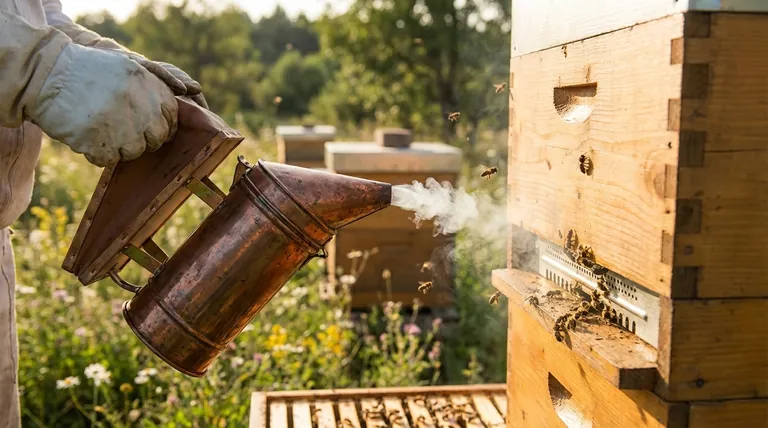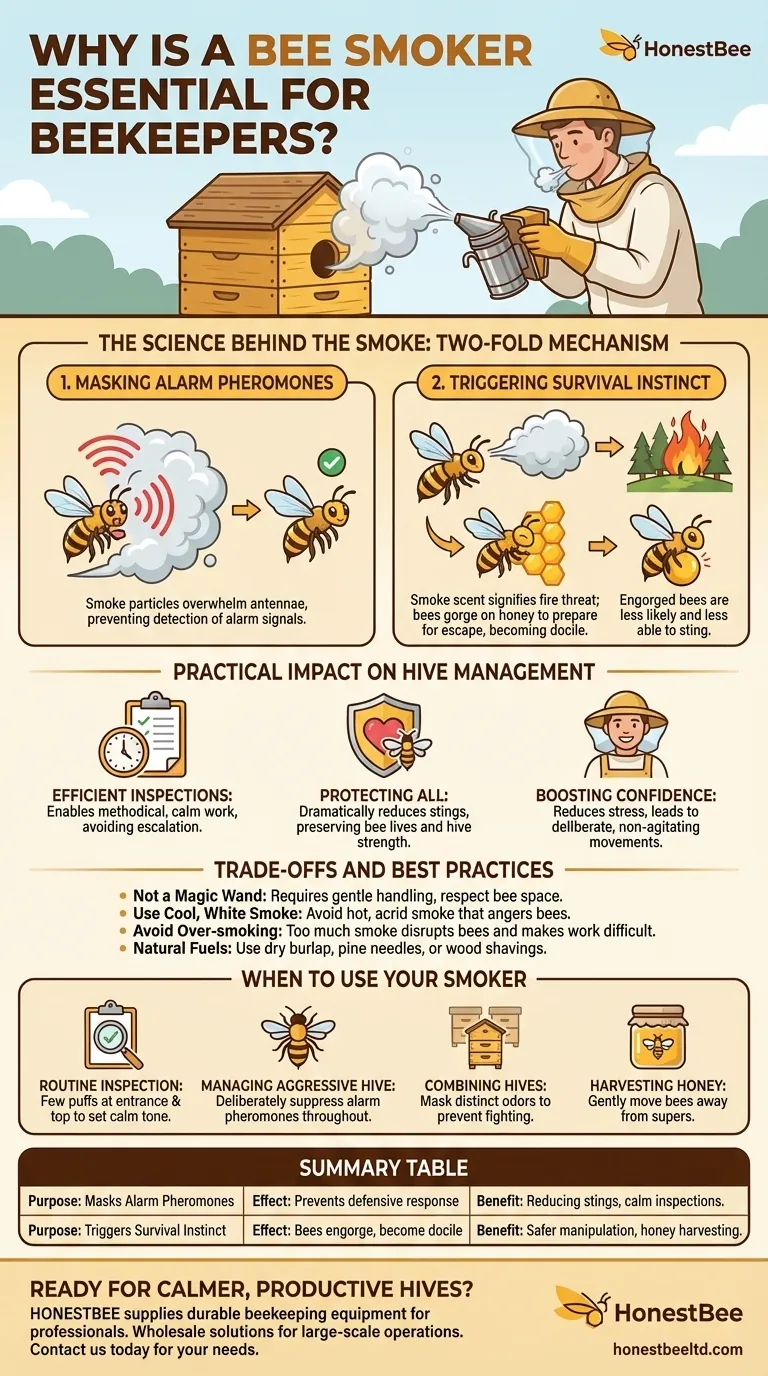At its core, a bee smoker is considered an essential tool because it chemically interrupts the honey bees' primary defense and communication system. By masking their alarm signals and triggering a secondary survival instinct, the smoke makes the colony significantly calmer and less defensive, allowing a beekeeper to safely and efficiently manage the hive.
The smoker is not simply a tool for "calming bees." It is a sophisticated device for communication that leverages the bees' natural instincts against them, temporarily disabling their ability to mount a coordinated defensive attack.

The Science Behind the Smoke: How It Alters Bee Behavior
A smoker's effectiveness is not magic; it is rooted in two distinct biological responses that disrupt a colony's ability to defend itself.
Masking the Alarm Pheromones
When a bee feels threatened or stings, it releases alarm pheromones. This chemical signal acts as a beacon, alerting other guard bees in the vicinity to the location of the threat and triggering aggressive, defensive behavior.
The thick smoke from a smoker physically masks these pheromones. The smoke particles overwhelm the bees' antennae, which they use to smell. Unable to detect the alarm signal, other bees do not become agitated, and a chain reaction of stinging is prevented.
Triggering a Survival Instinct
Smoke also triggers a more primal instinct in honey bees. The scent of smoke signifies a potential forest fire, which poses an existential threat to the hive.
In response, the bees' priority shifts from defense to survival. They begin to engorge themselves on honey, preparing to potentially abandon the hive and take as much food with them as possible. A bee with a full belly is more docile and finds it physically more difficult to flex its abdomen to sting.
The Practical Impact on Hive Management
Understanding the science reveals why the smoker is indispensable for safe and effective beekeeping, far beyond just preventing a few stings.
Enabling Calm and Efficient Inspections
Without a smoker, a routine hive inspection can quickly escalate. A single crushed or agitated bee can trigger a full-scale defensive response, making it impossible for the beekeeper to work calmly. The smoker ensures the beekeeper can proceed methodically.
Protecting the Beekeeper and the Bees
The most obvious benefit is the dramatic reduction in stings for the beekeeper. However, it also protects the bees. Since a honey bee dies after stinging a mammal, preventing stings preserves the lives of the colony's workers, maintaining the hive's strength.
Boosting Beekeeper Confidence
For new and experienced beekeepers alike, working with a calm colony is less stressful. This confidence leads to slower, more deliberate movements, which in turn makes the beekeeper less likely to agitate the bees, creating a positive feedback loop of calm.
Understanding the Trade-offs and Best Practices
While essential, a smoker must be used correctly. It is a tool for finesse, not brute force, and improper use can be counterproductive.
It Is Not a Magic Wand
A smoker calms bees, but it does not make them harmless. Beekeepers must still use slow, gentle movements and respect the bees' space. An overly aggressive beekeeper will still provoke a defensive response, smoke or not.
Use Cool, White Smoke
The goal is to produce a thick, cool, white smoke. Hot, acrid smoke from poor fuel or an improperly managed smoker will anger the bees and can even harm them. Use dry, natural fuels like untreated burlap, pine needles, or wood shavings.
Avoid Over-smoking
Too much smoke can be disruptive. It can drive bees off the comb, making it difficult to find the queen or inspect brood patterns. A few gentle puffs at the entrance and under the top cover are often all that is needed to begin an inspection.
When to Use Your Smoker
Using your smoker is not just about avoiding stings; it's about proactively managing the colony's mood for specific tasks.
- If your primary focus is a routine inspection: Use a few puffs at the entrance before opening the hive and a little smoke across the top of the frames to set a calm tone for your work.
- If your primary focus is managing an aggressive hive: Use the smoker more deliberately to ensure alarm pheromones are continuously suppressed throughout the inspection.
- If your primary focus is combining hives or splits: Use smoke to mask the distinct odors of each colony, which helps prevent fighting as they merge.
- If your primary focus is harvesting honey: Use smoke to gently encourage bees to move down and away from the honey supers, making removal cleaner and less disruptive.
Ultimately, mastering the bee smoker is about learning to speak the bees' language, using their own instincts to foster respect and cooperation.
Summary Table:
| Purpose | Effect on Bees | Benefit for Beekeeper |
|---|---|---|
| Masks Alarm Pheromones | Prevents coordinated defensive response | Reduces stings, enables calm inspections |
| Triggers Survival Instinct | Bees engorge on honey, become docile | Safer hive manipulation and honey harvesting |
Ready to work with a calmer, more productive hive?
For commercial apiaries and distributors, having reliable, high-quality equipment is the foundation of successful beekeeping. A well-maintained bee smoker is your first line of defense for safe and efficient hive management.
HONESTBEE supplies the durable beekeeping supplies and equipment that professionals like you depend on. We understand the demands of large-scale operations and provide wholesale-focused solutions to keep your business thriving.
Contact our team today to discuss your equipment needs and discover the HONESTBEE difference.
Visual Guide

Related Products
- Premium Traditional Copper Bee Smoker with Bellows
- European Stainless Steel Bee Smoker for Honey Bee Hive
- Heavy-Duty Bee Smoker with Durable Plastic Bellows for Beekeeping
- Heavy Duty Manual Bee Smoker Blower for Beekeeping
- Professional Bee Smoker with Elongated Spout and Durable Bellows for Beekeeping
People Also Ask
- How did early beekeepers use bee smokers? Master Ancient Bee Calming Techniques
- What is the primary purpose of using smoke in beekeeping? Calm Bees for Safer Hive Management
- What are some alternatives to using smoke in beekeeping? A Guide to Gentle Hive Management
- What are the benefits of using smoke properly in beekeeping? Achieve Calm, Safe Hive Inspections
- What is a Smoker and how is it used in beekeeping? The Essential Tool for Calm, Safe Hive Inspections



















